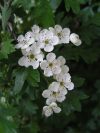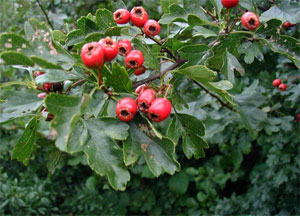It’s no secret that cardiovascular disease (CVD) remains the #1 killer in the United States. Estimates are that 81,100,000 people in the United States have one or more forms of CVD (approximately one out of every 3 deaths in the US). Apart from this, over 10 million Americans suffer chest pain or discomfort (angina pectoris) from reduced blood supply to the heart.
Before discussing one of the most powerful herbs for the treatment and prevention of this problem, I would like to recommend one herb that should be in everyone’s first aid medicine chest: cayenne pepper (Capsicum frutescens). It is a first line defensive herb for most acute conditions ranging from the common cold and flu to low energy. For the cardiovascular system, it acts as a powerful stimulant, an herbal version of nitroglycerine for the heart. Don’t be afraid to take it at the first sign of a heart attack. In the future I will dedicate an entire half-hour webinar singing the praises of cayenne pepper for health and healing.
This series of three blogs are dedicated to a few of the most powerful herbs in the world used for the treatment of cardiovascular disease, including angina, high blood pressure, congestive heart failure, and artherosclerosis.
Hawthorn
Sometimes called ‘May flower’ because it blooms in May, there are more than 300 species of hawthorn throughout the world. The word ‘hawthorn’ comes from the old English ‘hedgethorn’ because of its use throughout Europe, especially the British Isles, as a thorny living fence.
Used as a heart tonic in early Greek and Roman times, hawthorn was widely used in the Middle Ages for the condition called dropsy which refers to the swollen abdomen associated with congestive heart failure. It was also used for other heart diseases as well as sore throat. Introduced to North America by the early colonists, hawthorn was quickly adopted by the Native Americans as a valuable herb for the heart.
The berries are the most popular part used for medicine, but recently the leaves and flowers were found to be as high or higher in heart-beneficial flavonoids. In fact, the berries of hawthorn resemble rosehips, and it would not be much of a stretch to consider that part of the antioxidant effect of hawthorn is similar to rosehips because of a probable high content of Vitamin C.

Hawthorn Flowers
Traditional Chinese Medicine (TCM) traditionally employs the sour taste of the berries as a digestive, particularly for fats and proteins, which in turn, benefits the cardiovascular system. In recent years the Chinese have also adopted its Western herbal usage for the treatment of various heart conditions.
Hawthorn has been shown to work by expanding the blood vessels to allow more oxygen-enriched blood to feed the heart muscles. As a result, it increases the strength of the heart while only slightly increasing its speed. Hawthorn’s mildly calming properties help to promote sound restful sleep in hypertensive states.
As with other heart medications, while improving the pumping power of the heart, hawthorn can be used for congestive heart failure (CHF). At present there are at least nine published placebo-controlled, double-blind studies corroborating the benefit of hawthorn for mild to moderate congestive heart failure. The dose used in these studies was between 900 to 1800 mg of the standardized extract of hawthorn, given daily over a period of 16 weeks. While one may certainly be advised to seek qualified medical help for this condition, hawthorn, along with other heart herbs, offer certain advantages over all conventional drugs because they have demonstrated reasonable efficacy, comparative safety and broader health benefits with little or no adverse side effects.
Many heart medications cause palpitations and arrhythmias. Hawthorn is a good remedy for these conditions and will help strengthen the heart against these side effects. One of the ways it may work is by lengthening the refractory period, which is the brief period that immediately follows a heartbeat. By so doing it makes a premature beat far less likely and protects against dangerous breaks in the heart’s rhythm.
Finally, hawthorn is among the safest of herbs. The extract of the leaves are approved by both the New York Heart Association and Germany for the prevention and treatment of angina and mild to moderate heart failure in patients who do not have any physical limitations due to heart disease. Hawthorn can be used safely with other heart medications and drugs, with studies showing that it compares well with Captopril in treating Stage II heart disease. Instead of being subjected to any one of a number of therapies or drugs with long lists of warnings and reported adverse reactions, consider talking to your cardiologist about adding hawthorn to your regimen.
Dosage
The usual dose of hawthorn is 300 to 600 mg 3 times daily, or 900 mg twice daily of a standardized extract containing from 2% to 3% flavonoids or from 18% to 20% procyanidins. Herbalists tend to recommend whole herb preparations, which in alcoholic extract form might be as much as a half to a full teaspoon 2 or 3 times daily. This is an herb that is taken over a long period of time and while immediate benefits might be experienced sooner, fuller and more lasting benefit is seen over a period of 6 months or longer.
Safety Issues
Germany’s Commission E lists no known risks, contraindications or drug contraindications of importance to the majority of heart patients.
However, herbs such as hawthorn that benefit the heart because of their varying degrees of blood-moving (blood-thinning) properties may interact with blood-thinning Coumadin drugs such as Warfarin. For this reason and the risk of suffering a severe stroke or heart attack if a condition is too advanced, seek qualified conventional medical advice. The important point here is that the choice that is yours to make whether to embark on treatment using a number of drugs with a plethora of known adverse reactions, or try hawthorn or any of the other herbs I will be describing in forthcoming blogs.
Despite its mild blood-moving properties, hawthorn is not contraindicated for use during pregnancy.
Clinically I have treated numerous patients with cardiovascular disease. One patient suffering from severe angina was told to take a teaspoon of hawthorn liquid extract and the symptoms were relieved with 45 minutes. He then took it twice daily for prevention and never experienced the sometimes crippling chest pains again.
Generally, patients with congestive heart failure who seek my assistance suffer from very advanced conditions. Hawthorn alone is not enough to treat such advanced CHF, but in most cases, hawthorn used in formula with a holistic balanced diet and lifestyle and careful monitoring by a cardiologist is able to offer tremendous benefit.
Those seeking a personal consultation may call the East West Herb Clinic at (831) 429-8066.
Pittler MH, Schmidt K, Ernst E. Hawthorn extract for treating chronic heart failure: meta-analysis of randomized trials. Am J Med. 2003;114:665-74.
Degenring FH, Suter A, Weber M, et al. A randomised double blind placebo controlled clinical trial of a standardised extract of fresh Crataegus berries (Crataegisan®) in the treatment of patients with congestive heart failure NYHA II. Phytomedicine. 2003;10:363-9.
1. Popping S, Rose H, Ionescu I, et al. Effect of a hawthorn extract on contraction and energy turnover of isolated rat cardiomyocytes. Arzneimittelforschung. 1995;45:1157-1161.
Schulz V, Hansel R, Tyler VE. Rational Phytotherapy: A Physicians’ Guide to Herbal Medicine. 3rd ed. Berlin, Germany: Springer-Verlag; 1998:91-94

